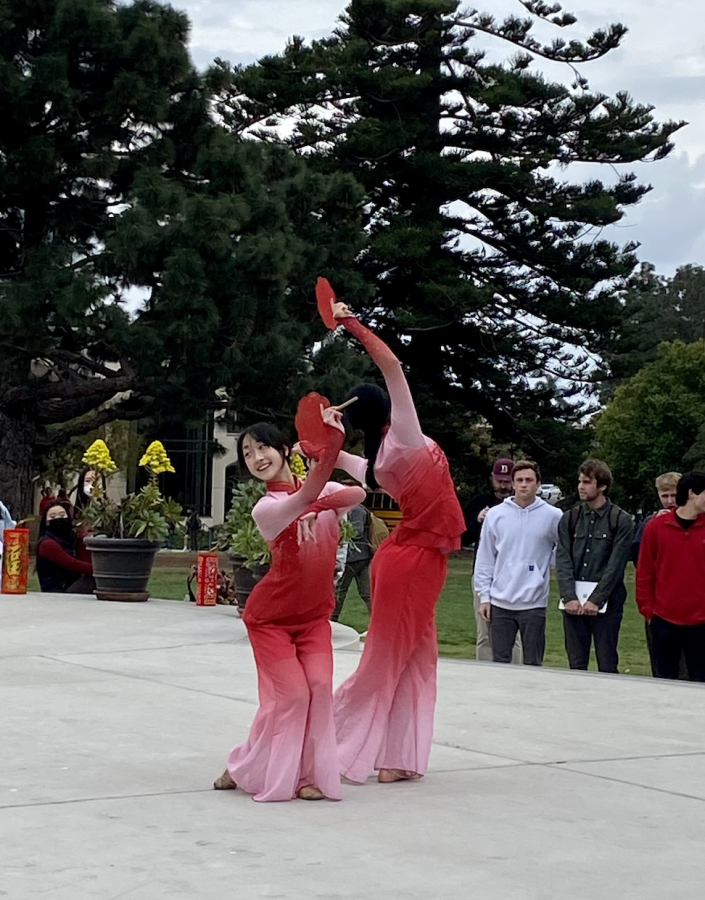Eye of the Tiger
A look into how Bishop’s celebrates Lunar New Year
Sisters Ellen Wang (’25) and Katelyn Wang (’23) perform together on the terrace during the Lunar New Year celebration.

With Lunar New Year just passing, many Asian countries such as China and Korea have prepared for the many festivities and unique traditions of each culture. Many Bishop’s students have many personal traditions when celebrating this holiday. Compared to the Gregorian Calendar used internationally, this holiday follows the Lunar calendar. Since the Lunar calendar is based on the moon cycles, the date of Lunar New Year varies from year to year, ranging from January 21 to February 20. This year, it starts on February 1.
Alongside the use of the Lunar calendar, this particular new year is the year of the tiger, the third member of the twelve zodiacs. These zodiac animals originate from China but are also used in other Asian countries like Singapore and Vietnam. However, the Chinese zodiac system is different from the astrological zodiac system that includes Aries or Pisces that many students are familiar with. Every twelve years is one complete cycle of the Chinese zodiac, starting with the year of the rat and ending with the pig. This year, kids born in 2010, the year of the tiger, will complete their first cycle. For these students, and for anyone born in that particular zodiac year, wearing red, usually in bracelet form, until the next Lunar Moon is a common tradition in China. The color red symbolizes good fortune and wards off evil.
According to the legend of the Nian, the color red played a key role in protecting the citizens of Ancient China. “People would be terrorized by a mythical monster called ‘Nian’ every Lunar New Year. It would eat and kill people, and destroy their homes,” Nason Li (‘25), a Chinese student, recounted. “Fed up with the constant attacks, people put up red banners on their doors and set off fireworks on new years day. Fortunately, the monster, Nian, terrified of the color red and loud noises, ran away.” Ever since then, Chinese people have continued to put up red banners and set off firecrackers on this fun-filled holiday. This story has many different retellings, but it details one of the most common traditions in China and explains why red is so important.
Not limited to decorations, red can be found on special envelopes that many Asian students love. Filled with money, a 红包(hóng bāo) is given to children each year to ensure good luck for the year ahead. With the invention of online red packets, people can also send money virtually using communication apps like WeChat. “Since practically my entire extended family lives in China, we talk over [messaging] apps like Wechat and exchange red envelopes,” Senior Haha Shi, a Chinese student, said. This tradition can be found in varying forms in other countries like Korea during Lunar New Year. Angelina Kim (‘25), a Korean Student, mentioned, “ [I would] get 세뱃돈 (pronounced “saebaedon”), the Korean equivalent of red envelopes [during Lunar New Year].”
Alongside red envelopes, people wear traditional attire. “When I was younger and visited Korea during the Lunar New Year, I would dress up in 한복 (pronounced “hahnbok”),” Angelina continued. China also has special attire for such occasions. Usually made of silk, Chinese people wear “qipao” during Lunar New Year. “The most common colors these garments are found in are red and gold,” Elizabeth Jin (‘24), a Chinese student, explained. “Decorating the sides is unique embroidery.”
With traditional attire comes traditional meals. During Lunar New Year, food is a big part of the celebration. To celebrate the new year, “we eat 떡국 (pronounced “tteoguk”), a Korean soup with fish broth, rice cakes, and the option of dumplings,” Angelina commented. Fish is also a common dish found on the dinner table during Lunar New Year. In China, fish is a key item due to its symbolism. Fish in Chinese is pronounced “yú” sounds very similar to the Mandarin word for abundance or surplus, so eating it represents a prosperous year ahead. Like fish, dumplings are also a significant symbol. “[Dumplings] represent wealth because they are shaped similarly to Ancient Chinese gold ingots,” Nason noted.
On campus, the Global Education Program, the East Asian Student Association (EASA), and the Diversity, Equity, Inclusion & Justice (DEIJ) initiatives had set up special lunches and had specific activities planned to celebrate the event. There was red envelope making, lantern making, as well as Chinese and Korean snacks that are traditionally served on Lunar New Year. Around campus, there were many different decorations, including red lanterns, and tables full of dried fruit.

Joyce is a freshman and joined the Tower as a staff writer this year. She came to the Bishop’s School in six grade, and has watched everyone grow taller...

Sydney Chan is an Editor-in-Chief for The Tower dedicated to discovering unique stories and bringing them to life through her pieces. She especially loves...











